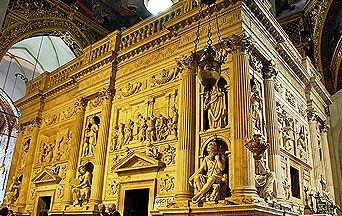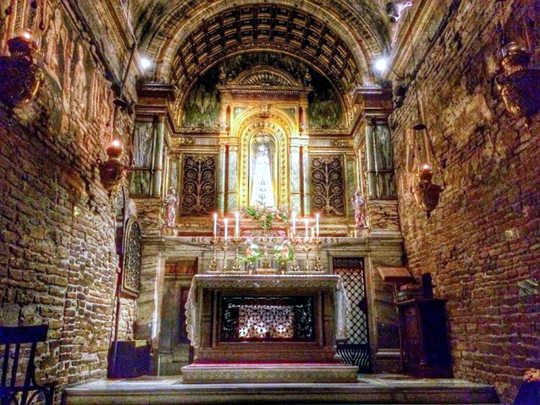
The Holy House of Loreto, located in Italy, was the house of Our Lady. Church historians agree that the abode was where the Annunciation took place. However, many also believe Our Lady’s connection to the house was much greater.
Thus, we can ask: Is the home of Nazareth, now in Loreto, also the place where Our Lady was born? Indeed, September 8, the Feast of the Nativity of Mary Most Holy, is solemnly celebrated in the sanctuary. Several Pontiffs (for example, Popes Julius II in 1507, Pius IV in 1560, Sixtus V in 1586, Clement VIII in 1595, and the Sacred Congregation of Rites in 1916) granted special indulgences and privileges for that day and confirmed in writing that the dawn of Redemption arose among those three holy walls: The birth of the Mother of God. Some popes, including Blessed Pius IX, went so far as to write that the Immaculate Conception of the Virgin Mary also took place there (Bull Inter Omnia, 1852).
Obviously, it is licit to discuss and have different opinions about this question. No one has absolute certainty about it, nor is it required for salvation. However, we may say that God wrapped certain events in mystery to help us better understand our smallness and stimulate us to investigate and occupy ourselves with “heavenly things,” lifting our gaze from the earthly.
However, we cannot ignore some unequivocal facts that would confirm the tradition.
Eternal and Natural Law: The Foundation of Morals and Law
Many Fathers of antiquity, including Epiphanius, Sinazarius Armenus, Hyppolite of Thebes, and above all Western ones, have always agreed with the so-called “Nazareth Thesis,” which has met increasing consensus over time, from the Middle Ages onward. Suffice it to mention Father Johann von Würtzburg, who cites Pseudo-Jerome: “She was born in Nazareth and in the very same room where, after the angel’s salutation, she conceived by the work of the Holy Spirit.”1
In effect, “In the story of the Annunciation and visitation, Luke suggests that Mary was from Nazareth, where she had her home. After telling the story of Mary’s visit to Saint Elizabeth, the Evangelist writes, “And Mary abode with her about three months; and she returned to her own house” (1:56).2
And since the Annunciation and Incarnation took place in that house, it is logical to believe that it was later chosen as the home of the Holy Family.

Moreover, several private revelations, such as those to the Venerable Mary of Agreda and Blessed Anne Catherine Emmerich, confirmed that the Holy Virgin was born in Nazareth. After the miraculous Translation of the holy walls to Trsat, Our Lady appeared to a local priest, Fr. Alessandro Giorgiewich, who cured him of dropsy and explained that in this house, she was born, grew up, and the Word became flesh.
Our Lady gave the same information in Italy, where she appeared to a hermit in Montorso (Loreto). Moreover, in the fifteenth century, both authors, Teramano and Mantovano, attest to Mary’s birth having taken place in the Nazareth house.
Science Confirms: Angels Took the House of Our Lady of Nazareth to Loreto
In 1578, in a booklet that Pope Gregory XIII ordered translated into eight languages, Teramano wrote, “The Blessed Virgin Mary lived in this room. Here she was born, educated, then greeted by the Angel Gabriel, and shadowed by the Holy Spirit.” For his part, Mantovano wrote, “The Temple of the Blessed Mother of Loreto was the very cradle of the Virgin, in which she was born, grew up, was greeted by the Angel Gabriel, and overshadowed by the Holy Spirit.”3
Teramano and Riera also wrote about the miracle of the flames, a noteworthy miraculous event seen as a divine confirmation of western tradition.4
Teramano recalls that on September 8, 1460, before nightfall, a local hermit, Paolo della Selva, saw a light in the sky descending toward the Holy House and spreading around the sanctuary. Torsellini recounts that the same phenomenon occurred in 1550 while a Jesuit priest was preaching in the basilica: Rays of clear light descended over the Holy House, stopped there for some time, and then spread over the crowd present there, finally returning to the sky and vanishing.
10 Razones Por las Cuales el “Matrimonio” Homosexual es Dañino y tiene que Ser Desaprobado
Father Riera, a historian, was an eyewitness of the event. Two years later, the miracle of the flames was repeated: a sort of comet appeared on the inner top of the dome, rested on the Holy House, spread once again over the faithful, and disappeared after pausing above the crucifix present in the Holy House. In 1554, the phenomenon took place outside and was also seen in neighboring towns near Loreto from two in the morning until dawn. Many other such cases have been recorded. In 1389, following these miracles, Urban VI granted the sanctuary a plenary indulgence for September 8. A six-pointed star was hung on the dome in memory of these events. Until the year 1972, on every December 9 (anniversary of the Translation, and not for the feast of the Nativity of Mary), the star was lit to the great joy of the faithful, especially the little ones.5
Finally, another truly significant miracle should be noted. In 1654, a friar of the order of Saint Francis, a convert to the Faith, entered the Holy House of Loreto with a rather skeptical mind towards everything that was said about it. As soon as he crossed the threshold, he immediately fell to the ground as if struck by an illness and even seemed close to death. He was taken out and tended to. When he came to his senses, he cried out in tears: “Yes, this is the birthplace of the Blessed Virgin Mary; this is the sanctuary where the Word was conceived.”
Science Confirms: Angels Took the House of Our Lady of Nazareth to Loreto
What happened? What made him change his mind so radically and dispel all his doubts? He explained that he saw the Mother of God with the Child Jesus looking at him with an irritated air and threatening him with the fire of hell. Struck by a healthy fear, he worked for the rest of his life to proclaim the truth about the Holy House venerated in Loreto.6
The above article is taken and adapted from Chapter 3 of the author’s book, The Miracle of the Holy House of Loreto.
Federico Catani was born in Jesi (Ancona) in 1986. He graduated in Political Science at LUISS—Free International University of Social Studies Guido Carli (Rome) and in Religious Sciences at the Pontifical University of the Holy Cross (Rome). He has taught Catholic religion in state schools and, as a journalist and publicist, he currently writes for various magazines and blogs in the Catholic world. He is a member of the Italian Society for the Defense of Tradition, Family and Property (TFP). He is the director of Spunti, a publication of the Association Luci sull’Est.
Photo Credit: © Zorro2212 — CC BY-SA 3.0
Footnotes
- Cit. in G. Gorel, La santa Casa di Loreto, cit., pp. 31-32.
- G. Santarelli, La Santa Casa di Loreto, cit., p. 198.
- For both quotations, cf. G. Gorel, La santa Casa di Loreto, cit., pp. 222-223.
- Cf. G. Gorel, La santa Casa di Loreto, cit., pp. 155-156.
- Cf. G. Santarelli, Tradizioni e Leggende Lauretane, cit., pp. 55 & ff.
- Cf. A.R. Caillaux, Histoire critique et religieuse de Notre Dame de Lorette, Paris 1843, p. 243.

